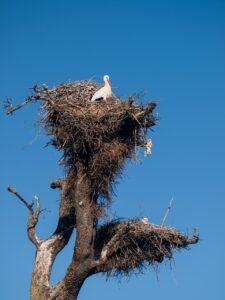I have been reading the resilience literature to create a simple framework that would be easy to grasp while providing a directional heading for our organizations and ourselves. This is the first of a series of blogs that reflect this theme — building resilience in our systems.
Resilient systems have polycentric governance systems.
In nature, we have single food chains and food webs that explain how species gain nutrients in an ecosystem. A single food chain is a fragile design because if any species go extinct in the chain, all the species above it will die. A food web, however, is more diverse and resilient. By design, a food web has multiple food sources available to multiple species in an ecosystem. It allows for redundancy in gaining access to nutrients; if one species becomes extinct, other food sources will fill in the gap.
Just like food chains, many of our organizations have hierarchies based on a command-and-control structure, These hierarchies depend on the resilience of each link in the chain to maintain the structure and effectiveness of the organization. For this reason (among others), resilience theory suggests that hierarchies / monocentric governance systems are quite fragile!
Hierarchies look and often behave like monocentric governance systems. What makes them fragile is that they depend on the effectiveness of every positional manager in the hierarchy – like a single food chain. Suppose a toxic leader becomes the CEO or manager, for example. The toxicity will spread below that position (and ultimately the whole organization) and becomes less engaged, less innovative, more self-protective, and less productive.
It’s not that hierarchies are always bad. Hierarchies can work well if everyone in positional leadership or management roles is effective, emotionally intelligent, and serves the organization’s interests over themselves. The problem is that we are human; as such, none of us is a perfect living system. For example, there is a lot of hubris in our hierarchies, making them more fragile than we think. It also costs the organization more time, resources, and attention to solve problems with ineffective managers.
Can hierarchies be polycentric systems?
Many of the organizations I work in are hierarchical in basic structure, but most are working to create multi-level leadership pockets that exist throughout the organization. This kind of distributive leadership reflects more closely the polycentric governance found in resilient systems. It allows for healthy and less effective leadership behavior to co-exist in multiple pockets of the organization. If a less effective leader exists, other examples and pockets of high-performance teams help absorb the adverse effects and the organization can still evolve and serve its purpose. That is what makes a system resilient!
So, our leadership models can help our hierarchies support more distributive management practices. This allows us to create an organizational culture of engagement and innovation. By intentionally developing distributive, leader-full organizations, we can help our hierarchical organizational structures become more resilient and less fragile.
Lessons for personal application
Resilient systems are designed to scale up and down different levels within a system. So, the principle of polycentric governance can apply to our personal lives as well as our organizations. This week, it might be a good idea to ask a few questions not only for your organization, but for yourself also:
- Are there redundancies in our relationships and sources of support?
- Are we dependent on a single source of support, making us more fragile and less resilient?
- What can we do to create multiple centers of care and nutrients that we need to thrive?
I’m interested in your answers to these questions, and any thoughts you may have this week!







Like the action items suggested
This post puts me in mind of the Hopi’s Spider Grandmother who thought the world into existence by conscientiously weaving her webs.
Spider silk can stretch before it stiffens, which is what makes webs resilient and resistant to damage. A web – or organization – that can’t stretch to accommodate external forces when needed performs much less effectively.
Love the web analogy!
I’d love to post your blog on my site for Polycentric Leadership if you are open to that: https://polycentricleadership.com/
We’d be delighted to have you post the blog!